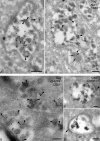HIV-1 assembly in macrophages
- PMID: 20374631
- PMCID: PMC2861634
- DOI: 10.1186/1742-4690-7-29
HIV-1 assembly in macrophages
Abstract
The molecular mechanisms involved in the assembly of newly synthesized Human Immunodeficiency Virus (HIV) particles are poorly understood. Most of the work on HIV-1 assembly has been performed in T cells in which viral particle budding and assembly take place at the plasma membrane. In contrast, few studies have been performed on macrophages, the other major target of HIV-1. Infected macrophages represent a viral reservoir and probably play a key role in HIV-1 physiopathology. Indeed macrophages retain infectious particles for long periods of time, keeping them protected from anti-viral immune response or drug treatments. Here, we present an overview of what is known about HIV-1 assembly in macrophages as compared to T lymphocytes or cell lines.Early electron microscopy studies suggested that viral assembly takes place at the limiting membrane of an intracellular compartment in macrophages and not at the plasma membrane as in T cells. This was first considered as a late endosomal compartment in which viral budding seems to be similar to the process of vesicle release into multi-vesicular bodies. This view was notably supported by a large body of evidence involving the ESCRT (Endosomal Sorting Complex Required for Transport) machinery in HIV-1 budding, the observation of viral budding profiles in such compartments by immuno-electron microscopy, and the presence of late endosomal markers associated with macrophage-derived virions. However, this model needs to be revisited as recent data indicate that the viral compartment has a neutral pH and can be connected to the plasma membrane via very thin micro-channels. To date, the exact nature and biogenesis of the HIV assembly compartment in macrophages remains elusive. Many cellular proteins potentially involved in the late phases of HIV-1 cycle have been identified; and, recently, the list has grown rapidly with the publication of four independent genome-wide screens. However, their respective roles in infected cells and especially in macrophages remain to be characterized. In summary, the complete process of HIV-1 assembly is still poorly understood and will undoubtedly benefit from the ongoing explosion of new imaging techniques allowing better time-lapse and quantitative studies.
Figures




References
-
- Ellery PJ, Tippett E, Chiu YL, Paukovics G, Cameron PU, Solomon A, Lewin SR, Gorry PR, Jaworowski A, Greene WC, Sonza S, Crowe SM. The CD16+ monocyte subset is more permissive to infection and preferentially harbors HIV-1 in vivo. J Immunol. 2007;178:6581–6589. - PubMed
Publication types
MeSH terms
LinkOut - more resources
Full Text Sources
Other Literature Sources

